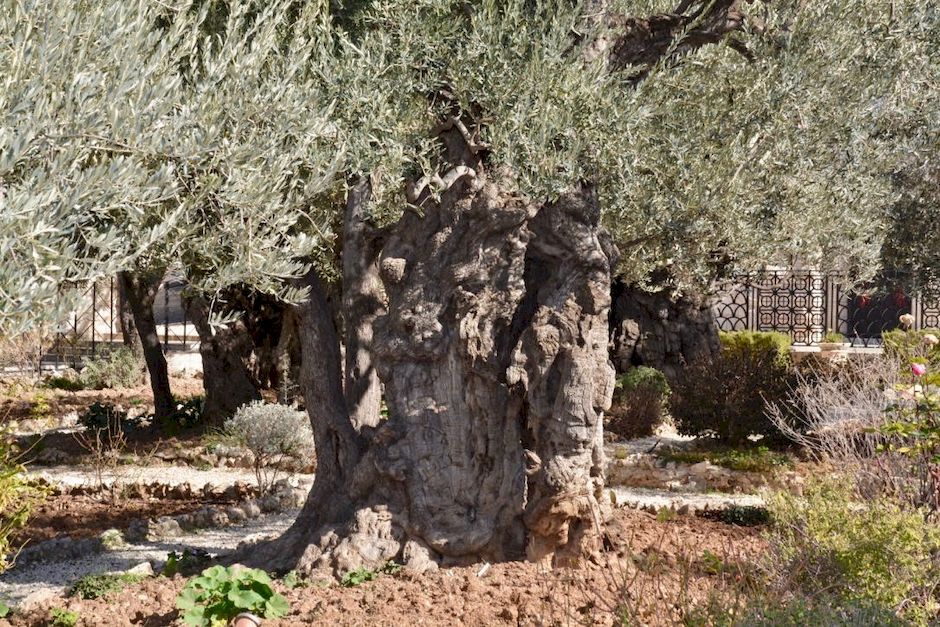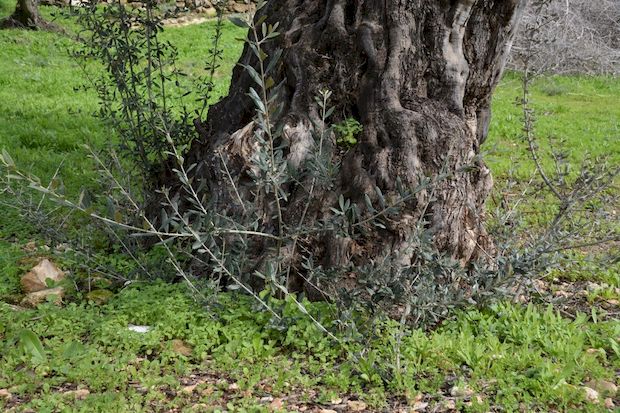The Olea europea is one of the most emblematic trees in the regions bordering the Mediterranean, and abundant in the Holy Land since remote antiquity. The Bible refers to it, and to the products that are obtained from it, on many occasions.
 An olive tree. / Photo: Antonio Cruz.
An olive tree. / Photo: Antonio Cruz.
When they had sung a hymn, they went out to the Mount of Olives.
(Mt. 26:30)
There are two Hebrew terms which refer to the olive tree. One is záyith, which was translated into Greek as elaía, and which can mean the olive tree proper and to its fruit, olives, or even the olive groves where the trees are grown (Ex. 23:11, Jos. 24:13; 1 Samuel 8:14; 2 Kings 5:26; Neh. 5:11; 9:25). The second term, ets-shemen, is only found in Isaiah 41:19, and means, literally, “oil tree”. In the Septuagint it was translated as kypárissos and xyla kyparíssina, and in the Vulgate as lignum olivae or olive oil.
The olive tree (Olea europea) is one of the most emblematic trees in the regions bordering the Mediterranean, and abundant in the Holy Land since remote antiquity, as is evidenced by the numerous olive presses that have been found by archaeologists. The Bible refers to it, and to the products that are obtained from it (olives and oil), on many occasions, as it was a source of food, and also of medication, ointment, fuel for oil lamps or a raw material for the elaboration of candles and soap. For this reason, the olive tree was a symbol of happiness, prosperity, peace and fecundity. It was a great blessing to possess olive groves, which was a common occurrence in Israel (Judges 15:5; 2 Kings 18:32).
The origin of the olive tree is lost in the mists of time, as olive leaf fossils have been found in Pliocene deposits in Italy, in sedimentary rocks of the upper Palaeolithic in North Africa and in Bronze Age excavations in Spain.

[photo_footer] Olive tree. / Photo: Antonio Cruz. [/photo_footer] It is thought to have originated in Asia Minor, where there are still multiple leafy olive groves. From there it spread eastwards as far as Iran and westwards throughout the whole Mediterranean basin. The existence of olive trees in the Holy Land dates back to some 12,000 years before Christ. They are long-living trees, up to thousands of years old, due to the fact that their trunks constantly produce roots and new shoots.
According to the Palestinian Ministry of Agriculture there are some specimens that are more than 4,000 years old, such as the famous Al-Badawi the great, in the village of Al-Walaja, in the district of Bethlehem, south of Jerusalem.
The Bible says that the dove released by Noah after the flood returned to the ark with an olive twig in its beak (Gen. 8:11).
In the story told by Jotham, in which the trees met to appoint their king, the olive tree was the first candidate that was put forward, but he turned it down (Judges 9:8,9). The holy of holies inn the Jewish temple also had two large doors, and two enormous cherubim, made of olive wood, each of them almost five meters high (1 Kings 6:23-33).
The Hebrews picked olives using the shaking technique, that is by shaking the trees until the olives fell. If a branch was accidentally broken and fell to the ground it had to be left for the benefit of the foreigner, the orphan or the widow (Is. 24:13; Deut. 24:20).
Undoubtedly, the olive tree’s worst enemy is the locust, and on certain occasions, God allowed plagues of these insects in order to make his people think (Am. 4:9).
Just as the old trunk of the olive tree surrounds itself with vigorous young shoots, so children are, according to the psalmist, like olive plants seated around the table (Psalm 128:3). In the New Testament, the apostle Paul also refers to the wild olive tree and compares it with the entry of Gentiles into the new people of God (Rom. 11:17-24).

[photo_footer] Olive tree. / Photo: Antonio Cruz. [/photo_footer]
The olive tree (Olea europea) is perennial, and can reach a height of 15 metres, with a thick twisted trunk and a broad treetop. The leaves are opposite and can be up to 8 cm long, lanceolate, and have a pointed tip; they have a dark top surface and a grey underside. Olives are succulent fruit (berries), very oily, green at first but then they turn dark after six months, and acquire a black-purple colour when they are fully ripe. Nearly a third of the pulp of an olive is oil. Hence, in ancient times, the was extracted by pressing them in mills for domestic, nutritional, medicinal and religious use. Olives are not usually eaten raw, because of the bitterness of their phenolic compounds, but rather are macerated according to taste.
The Bible mentions “anointing oil” about twenty times. It was poured over the head of the High Priest and his descendants, and also over the tabernacle and its utensils, in order to set them apart as holy and separated for the service of Yahweh (Ex. 25:6; Lev. 8:30; Num. 4:16). No other person could use this oil for any other purpose, on pain of excommunication (Exodus 30:32-33). A number of different substances were used in its composition, not only oil but also myrrh, cinnamon and other natural ingredients. No one thought that this oil had any miraculous or magical powers, but that the strict adherence to the instructions for its elaboration simply meant obedience to the will of God and, at the same time, an acknowledgment of his holiness. There are also references in the New Testament to this practice of anointing with oil.
Jesus’s disciples anointed the sick and they were healed (Mark 6:13); Mary anointed the feet of the Master as a form of worship (Luke 7:46); the elders of the church prayed for the sick, anointed them with oil and they were healed (James 5:14) and, finally, the book of Hebrews states that God anointed Jesus with the oil of gladness (Hebrews 1:8-9). Oil can also symbolise the presence of the Holy Spirit in the life of the believer, as in the case of the parable of the ten virgins (Matthew 25:1-3; 1 John 2:20).
The 19th century North American Presbyterian missionary, William McClure Thomson (1806-1894), wrote the following in his commentary on Psalm 128:
“Thy children like olive plants, etc. Follow me into the grove, and I will show you what may have suggested the comparison. Here we have hit upon a beautiful illustration. This aged and decayed tree is surrounded, as you see, by several young and thrifty shoots, which spring from the root of the venerable parent. They seem to uphold, protect, and embrace it, we may even fancy that they now bear that load of fruit which would otherwise be demanded of the feeble parent. Thus, do good and affectionate children gather round the table of the righteous. Each contributes something to the commonwealth and welfare of the whole—a beautiful sight, with which may God refresh the eyes of every friend of mine [1].”
[1] Charles Spurgeon, The Treasury of David

Las opiniones vertidas por nuestros colaboradores se realizan a nivel personal, pudiendo coincidir o no con la postura de la dirección de Protestante Digital.
Si quieres comentar o